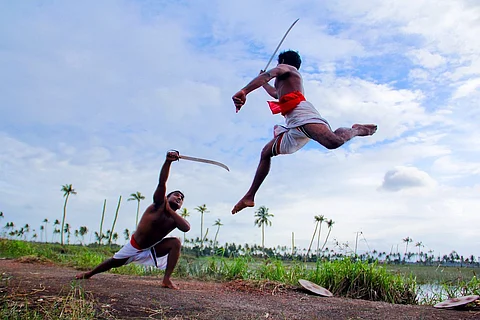

It’s not uncommon for age-old traditions and practices to fade away over the years. But in some cases, the passage of time allows their popularity to grow. Kalaripayattu, a centuries-old form of martial arts practiced in Kerala, is one such example. Across the state, small and large institutions host a number of students who continue to learn Kalari.
Kalaripayattu is believed to be one of the oldest surviving martial arts, and is over 3000 years old, and Lord Parashurama is said to be its creator. Realising the popularity of the form, the Kerala government has now introduced a Kalaripayattu academy in Thiruvananthapuram.
Padmashri Meenakshiamma, who has been honoured for her knowledge of Kalaripayattu and has received widespread praise, will also be taking classes at the academy.
The ancient martial art is a combination of intense dedication, patience, discipline as well as spirituality. Rigorous movements, complex jumps and tactical use of weapons — both wooden sticks and the sharo metal weapons — all make Kalaripayattu a visual treat.
The Kalari trainers, traditionally called Gurukkals, say that there has been a recent surge in interest for the martial art, and everyone embraces it for different reasons.
There are four different stages to learning Kalaripayattu — Meipayattu, Kolthari, Angathari and Verum kai prayogam. Body movements are first learnt in Meipayattu, allowing the student to develop their flexibility. The next stage is Kolthari, where students begin to grasp fighting techniques, including use of sticks. In the next level, weapons like Vaal, Paricha Urmi and so on, are used. The last stage is gaining the ability to fight without tools or weapons. The warriors identify the marma of their enemy and fight only using their hands.
SRD Prasad Gurukkal, who has trained many people in Kalari, says, "It is a comprehensive art with ethics attached to it. It has science in it and also has weapon-usage techniques".
Kalaripayattu is derived from the words ‘Kalari,’ which means “a place, or battlefield,” and ‘Payattu,’ which means “some action using arms.”
"What makes Kalari stand out is the ethics it carries in its culture. A student who starts learning Kalari will be taught only defense in the beginning. Only after learning those moves will he be taught offensive techniques. No other martial art follows that ethical culture," Prasad Gurukkal said.
It is believed that Kalari is one of the highest forms of physical and mental training.
"There are these four stages but it is not that only after learning the first stage completely we start the second stage. We start the first stage and just before it is done, we move on to the next stage. So in a way, one will be practicing all the stages together at one point of time," he said.
"There are no specific rules that Kalari can be learnt only by taking these many years. Some can learn it quickly and for some others it may take some time," he added.
Prasad Gurukkal noted that it is better for students to begin learning at a young age (arund 7 or 8 years) when the body is at its most flexible. “That is when our organs will be developed and flexible too,” he said.
Earlier, Kalari was taught to generations only as vaytharis (oral instruction). After 1936, the vaytharis on Kalaripayattu were written down and printed in book, and descriptive writings became more common after 1953.
"Many embrace Kalari for different reasons. Artists who do folk arts like Theyyam, Parichamuttu, Poorakkali, Poikali or Vela kali have used Kalari for their performances. Some Kathakali artists learn Meypayattu, some modern theater artists also use Kalari. For some others, it's a fitness activity" Gurukkal added.
Radhika M of Hindustan Kalari Sangam, the martial art school in Kozhikode which was started in 1950, said that before COVID-19, they had to stop admissions they did not have enough space for students.
She started learning Kalari around ages seven or 8 as her father was a Kalari gurukkal. Now, for the past 35 years, she has been practicing the martial art. She is also a Kalari healer for bone and joint problems, a form of treatment that is still popular in Kerala.
"For me, Kalaripayattu is spiritual. As per our Indian belief, our aim is moksha. So each stage of Kalari is a spiritual journey towards moksha for me. It keeps the mind under control and provides good health," she said.
She also noted that more girls are learning the martial art in recent times.
"Earlier it was learnt to fight wars. Now people use it for fitness. However, it has survived all these centuries because there is both ethics and truth behind it,” she said. At each level of learning, one’s concentration improves, she added. "Apart from self defense, Kalari brings discipline and gives one the ability to endure pain," she noted.